
ZEN is a series of discontinued portable media players designed and manufactured by Creative Technology Limited. The players evolved from the NOMAD brand through the NOMAD Jukebox series of music players, with the first separate "ZEN" branded models released in 2004. The last Creative Zen player, X-Fi3, was released at the end of 2011.

A portable media player (PMP) is a portable consumer electronics device capable of storing and playing digital media such as audio, images, and video files. The data is typically stored on a compact disc (CD), Digital Video Disc (DVD), Blu-ray Disc (BD), flash memory, microdrive, or hard drive; most earlier PMPs used physical media, but modern players mostly use flash memory. In contrast, analogue portable audio players play music from non-digital media that use analogue signal storage, such as cassette tapes or vinyl records.
Archos is a French multinational electronics company that was established in 1988 by Henri Crohas. Archos manufactures tablets, smartphones, portable media players and portable data storage devices. The name is an anagram of Crohas' last name. Also, in Greek (-αρχος), it's a suffix used in nouns indicating a person with power. The company's slogan has been updated from "Think Smaller" to "On The Go", and the current "Entertainment your way".
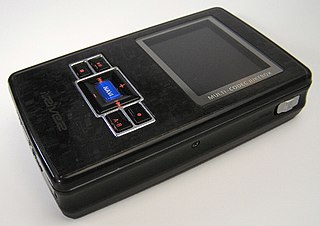
The iRiver H300 series are a series of portable audio players developed by iRiver, made up of the iRiver H320 and H340 models. They were first announced on September 22, 2004 replacing the H100/iHP-100. Each can play music, transfer pictures directly from digital cameras and UMS-compatible devices, such as flash drives, and display digital images on a colour screen. In the United States, the H320 initially retailed for $329 and the H340 was $429.
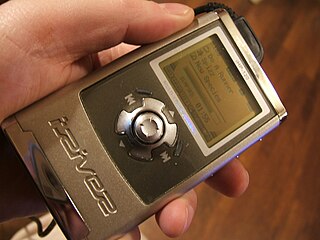
The iRiver H100 series is a series of discontinued portable digital audio players (DAP) made by iriver and originally released in October 2003. The models in the H100 series differ mainly in hard drive storage capacity. The players were succeeded by the iriver H300 series.

iAUDIO is the brand name for a range of portable media players produced by Korean consumer electronics and software corporation Cowon Systems, Inc.
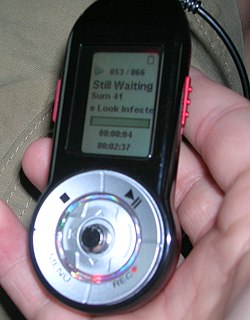
Lyra is a series of MP3 and portable media players (PMP). Initially it was developed and sold by Indianapolis-based Thomson Consumer Electronics Inc., a part of Thomson Multimedia, from 1999 under its RCA brand in the United States and under the Thomson brand in Europe. There were also RCA/Thomson PMPs without the Lyra name, such as the RCA Kazoo (RD1000), RCA Opal and RCA Perl. In January 2008, Thomson sold its Consumer Electronics part including the RCA brand and Lyra line to AudioVox. RCA-branded PMPs are still being made today in its domestic market but no longer under the Lyra name. The Lyra was an early pioneer in digital audio players, although in later years most of its output were OEM products.

Yepp was Samsung Electronics' digital audio player brand until Samsung decided to retire most of their family brands in February 2011. From then on, their MP3 players were simply branded "Samsung" worldwide until they discontinued all of them in late 2013. The brand included a wide range of hard-drive based as well as flash-memory based players. The name is claimed to be an acronym for "young, energetic, passionate person".

The MobiBLU DAH-1500i, colloquially referred to as the "Cube", is an MP3 player which is the world's smallest player with FM Radio and Sound Recorder at 24mm (0.94in) cubed. It features WMA-DRM, USB 2.0, and 512MB/1GB/2GB sizes in addition to the features on the Canadian DAH-1500s, such as:
The Gigabeat was a line of digital media players by Toshiba.

The iriver Clix is a portable media player that was developed and sold by iriver through two generations. The Clix was originally known as the U10, released in 2005. The next year it was revised and essentially rebranded to Clix. A second generation player, often called the Clix 2, was released in 2007, and later a minor revision called Clix+. The players are navigated by four buttons embedded on its sides, referred to as D-Click.

MPIO or Mpio was a South Korean consumer electronics brand and company. Established in 1998 by Woo Jung-Ku, it was one of Korea's early manufacturers of MP3 players and was known for producing portable digital audio players, media players and CD players capable of decoding MP3 data files on CDs. Previously, the company was known as DigitalWay Co., Ltd.

The Rio Forge is a digital audio player that was produced by Rio Audio, Inc. While it competed in the same market as Apple Inc's iPod mini, it is considerably different as it plays from internal memory, SD card, or FM broadcast and runs on a single AAA battery.
This article is about the technical specifications of various Creative MuVo series media players. The models listed here are organized by their release date with the older models at the top to the newer models at the bottom. All models use flash memory except the MuVo² & the MuVo² FM, which use hard drive.

SanDisk has produced a number of flash memory-based digital audio and portable media players since 2005. The current range of products bear the SanDisk Clip name, a line of ultraportable digital audio players. SanDisk players were formerly marketed under the Sansa name until 2014.
The Dell Inspiron Mini Series is a line of subnotebook/netbook computers designed by Dell. The series was introduced in September 2008 amidst the growing popularity of low-cost netbook computers introduced by competitors.
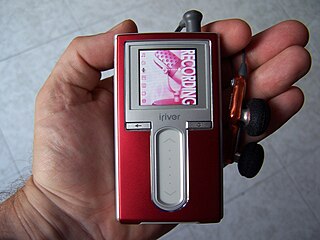
The H10 is a series of portable audio players developed by iriver, coming in multiple capacities and sizes. The player first went on sale in South Korea in December 2004 and rolled out internationally soon afterwards. The H10 series are hard disk based players coming in a 20 gigabyte form, along with smaller variants of 5 or 6 gigabytes. All versions come with a colour screen as well as voice recording and FM radio. Unlike most other iriver products, the H10 series does not play Ogg Vorbis. However, the device works well with the Rockbox alternative firmware which does play Ogg Vorbis.
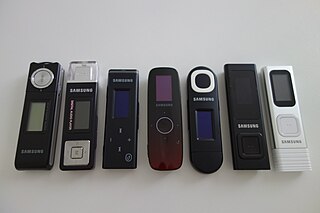
The Samsung Yepp U series is a line of USB key MP3 players made by Samsung and introduced in 2005 with the YP-U1. Samsung used to release a new device every year. Only the YP-U7 was released two years after the U6. It is the largest and most durable Yepp series. The most famous competitor is the Sony Walkman B series. In South Korea, the iRiver T series is also a main competitor.
The Walkman E Series is a line of digital audio (DAP) and portable media (PMP) players, marketed by Sony as part of its Walkman range. E Series devices have been marketed since 2000, although in its current form since 2008 as entry-level, candybar styled players.
The iriver Spinn is a portable media player that was developed and sold by iriver. It was announced at the 2008 Consumer Electronics Show and shipped later that year. It was a successor to the iriver clix 2.



























